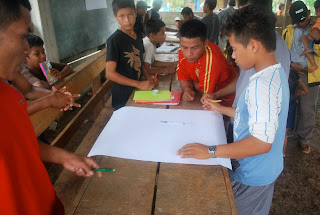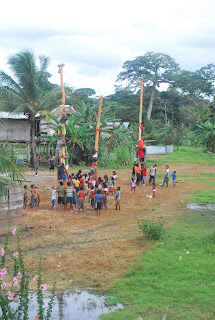Within the first three months, Peace Corps volunteers are also trained to conduct a Participatory Community Analysis with community members. The activities that I felt were appropriate to introduce into Alto Playón were a Community Map, Seasonal Calendar, and a Needs Matrix. The goal of these activities is for them to analyze their community, talk about the current problems, and ways to solve them. These are tools aren’t just information gathering. They can move communities to action and break the cycle of paternalism at exists in much of the developing world.
I met with various community members to explain them the activities so that they could be facilitators for the various groups: men, women, and young men. Drawing out little pictures of what the activities would look like helped them grasp the concept a little bit more. It took a lot of confidence building for them to become facilitators, which is part of this process. This sets the tone for my work here, that every activity or project that we do will be co-facilitated by community members.
Community Mapping Exercise
I set up 3 tables in the Casa Comunal for each group to work. It took a while for us to get started. Luckily, my co-facilitators came through and other community members stepped up to the task as well. Instead of only 3 maps, we came up with 5! Each group then presented their maps to the rest of the community, and I wrote down all of their ideas.
 |
| Young Men's group presenting |
 |
| Women's group sharing their map |
 |
| Young Men's group sharing their map |
 |
| Alfonso explaining the activity to community members after we finished |
This really helped them understand the point of the activity, and they started asking me questions as to what to do next to achieve their ideas. I was able to explain to them my role even further, that I can’t bring these projects to them. Once a community is organized, we can work together to formulate a project plan and solicit funds for it. Other members of the community then stood up and started talking about how I could be resource to the community, even calling me a ‘facilitator.’ Three days later the community held a meeting and started it’s first Health Committee. In the next 2 years, these will be the people that I work with.
Seasonal Calendar
The Seasonal Calendar exercise is a tool that helps community members look at their lives on an annual basis. It can be used to track fluctuations in labor patterns, health patters, income, etc. I spoke with the same facilitators that I used for the community map to ask them if/how this tool could be of use to them. My community counterpart, Esterio, mentioned that he could use this to understand all the products that are farmed in the community, and when the different plagues come that hurt their crops. I asked Ana, his daughter, to facilitate a calendar that maps out all of the diseases that come to the pueblo and when. The women were also able to use the calendar to plan out an artistan business and a bird raising business.
The activity went well, and it highlighted the need in the community for a group of farmers to get together to solicit ways that they can protect their crops from the plague that comes. It is possible for me to work with Sustainable Agriculture volunteers on helping them increase their rice yield, and this is good information to have.
 |
| My 2 host dads who are great |
Most interest to me was the women’s presentation about illnesses. They talked about diarrhea, vomiting, various skin infections, and malaria. I plan on using this information with the Health Committee to say that these are the illnesses we have here, explain what they are and where they come from, and what we can do to prevent them.






















